SH: Do you have a Kluane story? You’ve told stories from every park but Kluane.
Hal: Let me think about that one for a minute. (Hal started a story but wanted to change it).
Chambers and I fell off a mountain, we were climbing Mount McArthur, a 14,000-foot peak beside Logan. It was an expedition climb where you ferry goods and your camp up to successively higher camps until ready to go for the summit. I was a newbie, and I was on a rope with a warden from down south and Ron Chambers. We’d made the peak and we were starting back down, and we were on our toe points and ice axes as we traversed across a fairly steep ice slope, I’d guess maybe fiftyish degrees, I don’t know. Anyways it was mostly ice. Being the newbie, I was in the middle of the rope, and we were traveling across this face, all kind of spaced out and hit some ice that kind of dinner plated out on me. I was leaning up too high on my crampons. I hit the rope with a jerk and the fellow above me, came out of his stance and flipped onto his back. By that time, I had arrested myself but this other fellow goes rocketing by me on his back, in that instant I knew I was going to get pulled out. Then there’s Chambers below, off to the side, watching all this going on. Anyways, I get pulled out and now there are two of us rocketing by Ron, he dug in as hard as he could but he got pulled out like a cork out of a bottle. But he did pendulum us a little bit and we ended up landing on a fairly wide snowy ledge. If we had continued on our earlier trajectory, we were lined up to go over a 5000-foot cliff. We picked ourselves up and everyone had a few owies. It was pretty interesting. We still had to down climb to camp two or camp three or whatever it was. We had a tricky little gully we still had to go through too. Anyways it was a pretty good eye opener for a newbie.
SH: Did you like climbing after that?
Hal: Oh ya, I was a little shook up for sure you know, I adjusted and put it into perspective and ya, got back into it again later. So, there’s a Kluane story.
SH: That’s a good Kluane story. Do you have any others you want to tell?
Hal: I was going to ride in the Calgary Stampede parade. I was supposed to have taken Kit but when I got down to the ranch she wasn’t there, so I can’t remember who I grabbed, but I grabbed the next likely looking suspect, loaded her into the trailer and headed off to Calgary. Everything seemed good, I got there, and we did our thing that night. Everybody sat around and had a beer or two and told stories. It was good fun. The next day we were getting all dressed up and getting the horses looking good to ride in the parade and I’m second or third in line or something, and boy the horse is antsy and shy and jumping sideways. Well, at the time there’s a lot of different things going on. Television cameras had these big cables, and this guy had run out towards us, dragging this big cable. My horse was sure we were being attacked by snakes and dancing around everywhere and I’m starting to get looks from the rest of the crew. “Come on, control your horse.” Anyways, we got through, and I got the horse back and turned her loose, and I’m talking to whoever it was at the Warden Office, and I said, “That’s not a very good parade horse”. He starts laughing and says, “She’s only ever been used in the backcountry.” I rode in the Stampede Parade a couple more times and had a lot of fun. It was a good time and we got to wave the flag.
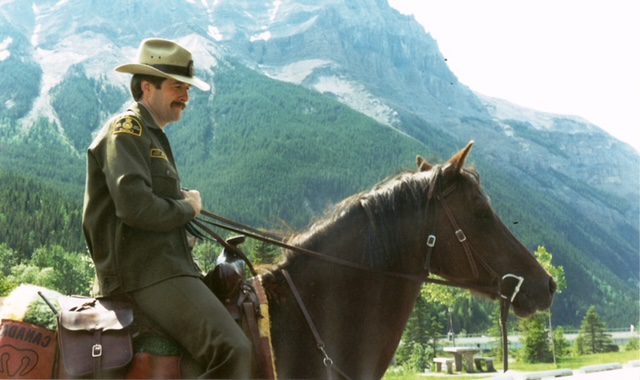
Hal on saddle horse in Yoho National Park
The Rockwall ride in the fall. MacArthur Cabin, Goodsir Pass, Helmet, Wolverine, Lower Ice, Leanchoil. Those were always spectacular rides, especially in the fall. It was a nice to time to be on patrol.
SH: Do you ever miss being a Warden?
Hal: You know I don’t think I do. I’ve got fond memories, but that was then. You can’t turn back time and I’m okay with that. That’s the natural order and progression of things. We’re pretty busy too; fishing, hunting, camping, kayaking. Janice and I rafted the Grand Canyon this past winter. A bit of travelling this coming winter and we’re just rigging up a canoe trip to do next summer. There’s always something going on. It’s just part of the adventure.
SH: Do you have any photos of yourself as a Warden that you would like to donate to the Project, or that we may copy? Do you have any artifacts/memorabilia that you would like to donate to the Project (Whyte Museum). (We discuss this off tape). (Tape 1:21: 40)
SH: We are going to do one more story.
Hal: This is a positive story about a female grizzly bear around Lake Louise. It was bear 72. She was first collared by Mike Gibeau as part of the East Slopes Study. She was kind of an unknown, very quiet, reclusive kind of a bear. She was a young female approximately eight years old when she was first collared. She quickly became more habituated because she started hanging out in the Bow Valley and any animal that wants to live there has to become habituated to some degree. We maintained that collar, the original study collar was replaced as the study wound up, but we kept her collared because she was a bear of concern. She ended up functioning in very close, tight around Lake Louise and Lake Louise campground, she had three sets of cubs in her lifetime and was successful in having some of those cubs recruited into the adult population.
She was a success story in that she died a natural death in her twenties. She did not become meat for the highway or railway. After I retired, she was still functioning, less than 100 meters from Lake Louise Campground, but on the right side of the electric fence, and right along the edge of the Lake Louise sewage treatment plant, right beside the Bow River. Things like sedges, and cow parsnip and a whole bunch of different natural bear foods grew surprisingly well right there. She loved that area, it was a critical piece of micro habitat for her for a certain period of time, but it was right hard alongside some of the campsite. Through the use of spatial and/or temporal closures and the E fence we were able to make it work in the Lake Louise townsite. Group of 4 in the Moraine Lake area played a big part in her being able to use that area safely. I can’t recall any instance of her being aggressive and there was certainly lots of occasion for her to have reacted to visitors especially when I witnessed a group of 7 or 8 people chasing her and her cubs in an effort to get a picture. Her level of tolerance was incredible when she was given the chance. Briana Burley who took over my role as Wildlife Human Conflict Specialist at LLYK, oversaw 72’s continued monitoring and she ended up dying a natural death as a grizzly bear that made it through her entire life in an intensely human used and developed area. (Tape Part 4 3:21).
SH: Note: I asked Hal to write up this great bear story following our interview.
Hal: I received a call from dispatch that a train crew believed there were black bear cubs on a train that was about to arrive in the Town of Field. Brianna Burley, BJ (Al Bjorn) and myself met at the level crossing in Field. The train stopped in Field and on one grain car there were 3 small cubs of the year cowering in a small sheltered area that was at the back of the platforms at either end of a grain car. BJ was up for the challenge and climbed up on the end platform decked out in welding gloves and a big fleece jacket. Bri climbed up beside him and I got a dog kennel ready. BJ managed to get his arm back to where they were huddled and grabbed one of the cubs by the scruff of the neck. It looked like he had a good hold of the cub high on the neck, but that cub spun 180 degrees in its loose-fitting skin and wrapped its legs around BJs arm. BJ was dealing with the cub’s head and sharp little teeth but wasn’t able to do much about this cub velcroing itself to his fleece covered arm. It was about this time that BJ let it be known that the fleece wasn’t quite thick enough and some of those sharp little claws were starting to make themselves felt on his arm. Bri was helping peel the cub off BJs arm so we could get it into the kennel I was holding. The cub now managed to wrap all 4 of its legs and claws onto Bri’s arm. Bri was not happy with how this was going and let it be known that she wanted this cub off her arm, pdq. I was working on prying the legs and claws off Bri’s arm while she dealt with the cub’s head.
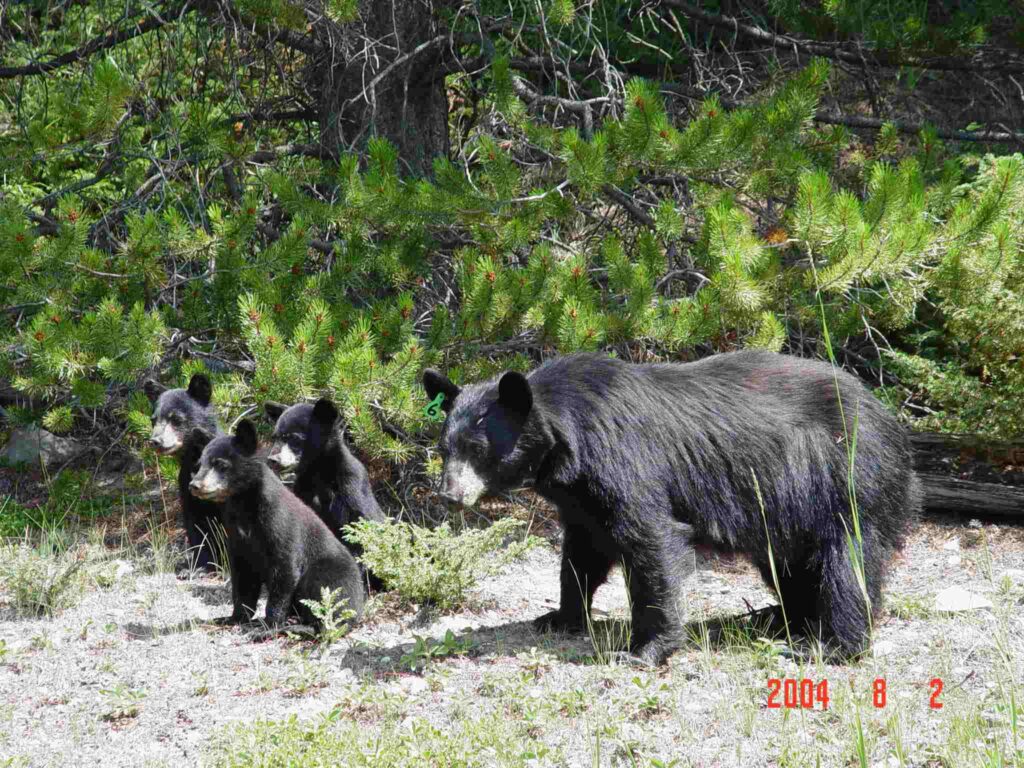
There wasn’t much room with BJ and Bri on the platform and me balanced on the knuckle connecting the train cars. It was quite the performance. We managed to get the little rascal into the dog kennel but it took quite a while to be able to get my arm out of the kennel without the cub velcroed to me. The next two cubs went a bit smoother until putting the last cub in the kennel with the other two already in there, but we managed to get it done.
I was thinking these cubs were likely from black bear #6 as I believe she was the only black bear in the Lake Louise vicinity that had triplets at the time. Black bear #6 was a highly productive young black bear that wasn’t a very good mom. She was addicted to working the railway tracks for spilt grain. The train crew told me they had been sided at the Great Divide siding and had seen a black bear family group there. It seemed likely she had climbed up 5 ft or so onto the end platform of the stopped grain car and those little cubs had somehow managed to follow her. When the train started moving it would seem she jumped off and left the cubs to ride the rails.
We headed up the highway towards Lake Louise with those little buggers bawling away in the back of the truck. We spotted #6 up on the tracks near Bath Creek corner and got within a couple of hundred feet. We opened up the canopy on the truck so the cubs’ bawls could be heard. She came racing down the slope towards the truck so we let them out on the shoulder of the road and the sow and cubs rushed to each other. It was kind of a heartwarming homeward bound type moment. We had many other adventures with #6 over the years. She left cubs on grain trains at least one other time where we had to intervene and misplaced a cub(s) at Lake Louise Campground and in the Townsite. Number 6 accounted for a few other funny/goofy “occurrences”.
SH: What year did you retire? What do you enjoy doing in retirement?
I retired in 2013 and Janice and I moved to the coast. We have a half-acre lot out here. My sons and I had built a shop with a suite up top, so Janice and I moved into the suite, which was not much bigger than a warden cabin, about 400 square feet, and we lived in there for three years while we built the house. We had a lot of fun building the house together and have a nice house. I got to use some of the wood that I’ve been collecting for 25 years. We did everything ourselves. We drew up the plans, did everything, including the plumbing and the electrical. The only thing we didn’t do was the drywall and thank goodness for that. I’ve taken up blacksmithing which is a lot of fun, and very satisfying, and there’s always lots of woodworking and stuff.
SH: You obviously like hunting and fishing. Freshwater fishing or saltwater?
Hal: Oh ya, every year we have a big two-week trip into the interior and spend two weeks on a lake there with family and friends and then during the summer we have at least two salmon fishing trips to the outer west coast, out towards Nootka Sound and the Bamfield area. Actually, we are going to head off in two or three days and go fishing with Will and Sue Devlin out at Bamfield. The salmon fishing out front of Hornby hasn’t been too bad this year. I can have the boat launched and be out fishing in ten or fifteen minutes, so pretty deluxe.
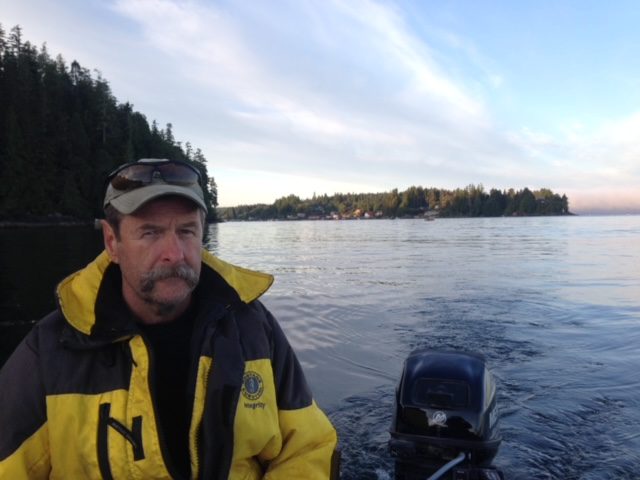
Enjoying retirement salmon fishing at Bamfield
SH: Is there anything I haven’t asked you that you think I should know about the Warden Service?
Hal: I think we’ve pretty much covered it eh?
SH: Is there anyone else I should talk to?
Hal: Yves Bosse, Al Gibbs , Tom Hurd, Terry Winkler, Chuck Blythe.
SH: Thanks. (Tape end Part 3: 2:59)
Susan Hairsine worked for Resource Conservation and Operations in Mt. Revelstoke/Glacier, Jasper and Banff National Parks, as well as for Public Safety in Western and Northern Region for over 30 years. She obtained funding for an oral history of Parks Canada’s avalanche personnel and oversaw the successful completion of the project. Her experience working with several the interviewees during their careers has been an asset to the current project. She was also the Executive Assistant to the Chief Park Wardens of Jasper and Banff National Parks.
End/sh.
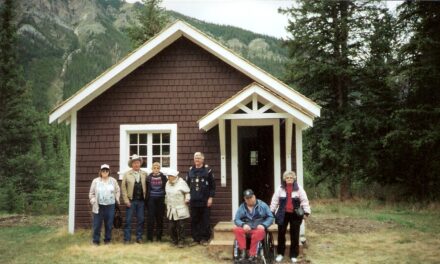

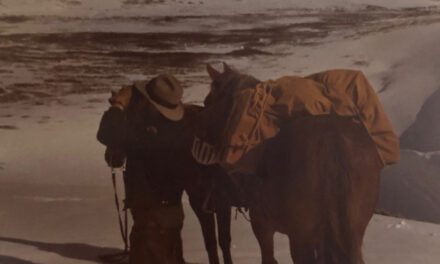
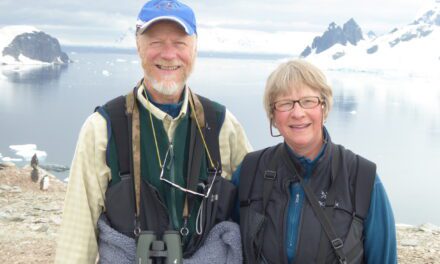
This was a great read, glad I had the pleasure of working with Hal in Cape Breton Highlands National Park . Janice used to make us a wicked cup of “stake out “ coffee to take out on night time poaching patrols.